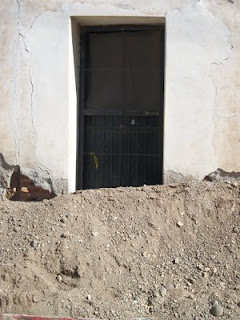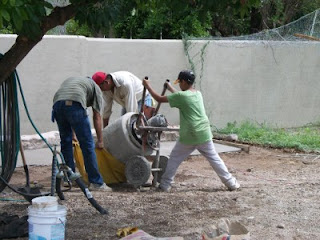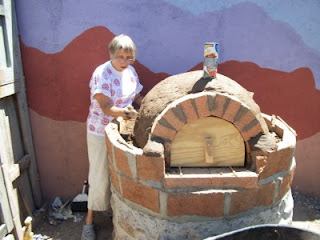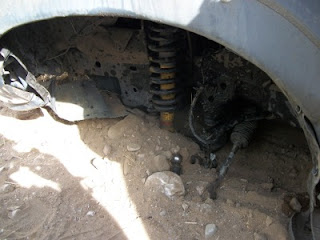 |
| Smashed Street |
The guys in our tiny expatriate community became critical--after all, that is the way of the American intellectual. "I criticize, therefore I am." They said that the RIGHT way to do this would have been to plow up perhaps one block at a time, get the pipe in quickly and close up the holes before going on to the next section so the hassle to the population would be minimized. But here, noooo. It soon became evident that the crew intended to dig up the entire town and only then begin to lay the pipe.
 |
| Trench and Pile Outside Our House |
 |
| What Front Door? |
Worst of all, the work moved at a glacial pace. There were maybe 10 guys working, scattered here and there throughout the town. We saw one poor guy all on his own, sweating profusely as he filled in a trench that ran the entire length of town by hand on Calle Obregon. Every now and then the mechanical poker was seen digging up yet more small streets and alleys.
The work started in October, and when we arrived in November, it seemed that not much progress had been made. We stayed a couple of weeks during which minimal progress occurred, although the workers did sort of clear the parade route for the Día de Revolución on November 17th.
 |
| Our Perky Blue Water Line |
When we arrived in December, we were again greeted by mountains of dirt and rock piled across from our house and blocking the nearby intersection of Obregon and Galo Trevino. The blue plastic lines still stand proudly at attention. No one seems to know how they will be connected to the house lines. For ours, someone will have to cut through 4 feet of elevated concrete sidewalk and a couple of feet of faux brick walkway. At Dan and Tracy's house next door, the blue pipe was lined up with the sewer instead of the water line, and someone will have to cut through a wheelchair ramp to attach it. Who will that someone be? There has been speculation that each property owner will be responsible for the connection themselves. No one knows how or when we will be connected to the new system. When they turn on the new system will the pressure blow the baling wire off the house pipes, leading to geysers all over town? Quién sabe (who knows?)
Our American friends have repeatedly complained to the Mayor. That's what we would do in the US. The Mayor has maintained that the construction is the project of the State of Sonora. It is not a city project and so he has refused to get involved. His term expires next summer. Complaints go nowhere.
This is where the story takes a turn toward the collision between inconvenience and cultural and social norms. In the US, complaints are taken seriously. More often than not, complaints are acted upon and make a difference. When they are not, lawsuits quickly ensue! But complaints do not seem to be part of the Mexican approach to problems. That seems to run more toward solving the problem for yourself - like Chuchico did! If you don't like the trench, just fill 'er in! Confrontation and loss of politeness are not part of the society here.
It is astounding to me that the locals do not rise up in protest. Generally they just shake their heads, perhaps grumble a bit about how ugly and inconvenient the torn up streets are, and then go their way, The most they might do is individually shovel a path or fill in a trench to make their immediate lives easier. They would rather lift baby strollers across the trenches than to complain to someone who could do something. There seems to be no understanding of the possibilities of collective action.
We also noticed this when the mine first came to town. Some of the Americans here at the time tried to hold protest meetings to discuss the evils the mine might inflict on Banamichi and the Rio Sonora Valley. The locals did not participate. Grassroots action is not their way.
While the Occupy Wall Street Movement has been happening in New York and other cities in the Western world, it is almost inconceivable here. Yet there is great economic disparity - Mexico is the home to Carlos Slim, the richest person in the world, yet we know someone who ekes out a living for her family by baking pastries and selling them door to door. She is not alone in her poverty. Just drive around Hermosillo and note the disparity in housing. Even here in Banamichi there is a home that looks like a beachfront mansion, and a whole lot of one room basic cement block houses on the "wrong" side of the main street. There is ample reason for the Occupy Movement to take hold here, but that has not happened. It just does not seem to be part of the Mexican collective consciousness to protest in that way.
Back at the construction site, access to our friends Tom and Lynn's hotel was already closed off on two streets. When the poker arrived and began chopping up the pavement on the third and last possible access street, Tom's frustration reached a limit. Guests were arriving in a few days and not only could they not park anywhere near the hotel, they would have to climb the dirt heaps with their luggage. The situation was in fact truly outrageous. In the US, the contractors would long since have been sued.
Tom demanded to see "el jefe" (the boss) for the job. Neighbors gaped slack jawed at the unaccustomed confrontation. No one knew what to do. Someone called the police.Vicky (our friend and the city accountant) was called to interpret and intervene. Finally, Tom was promised that the streets would be open by Thursday, in time for his guests to arrive and park. Tom got what he needed - the street was indeed (sort of) open by Thursday. Breaching the norm worked, if only for the people on Tom's block!
If a Mexican had behaved like Tom, he would be laughed at (behind his back because Mexicans are always polite), and perhaps little by little lose his social standing if this behavior continued. People who disobey group norms always pay a price. They make the group uncomfortable, and it seems to be part of human nature to push away of the source of discomfort rather than to analyze and change the norm. I can just imagine the locals gossiping about Tom's success.They probably attribute the outcome to his being an American.
What is the right way and the wrong way to approach something like this? I don't think there is a universal answer. Culture is a set of social behaviors that is deeply imbedded and mostly unconscious. Observable behavior is only the tip of the "cultural iceberg*." Cultural attitudes are an undeniable and inescapable part of each person's identity. They are not easily changed. The Mexican passiveness in the face of all this disruption is hard for me as an American to understand. But then that is precisely why I enjoying living here - to experience the differences and thereby become more conscious of my own cultural conditioning. Every interaction becomes a challenge to see simple everyday things with new eyes. Every interaction is an opportunity to examine my assumptions about life and human nature. Every day brings new awareness and understanding. Viva la differencia!
* Do check out this link! There is a great diagram that shows very clearly what I am saying.






























